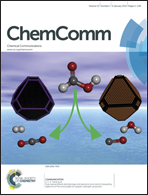Three-dimensionalization of ultrathin nanosheets in a two-dimensional nano-reactor: macroporous CuO microstructures with enhanced cycling performance†
Abstract
Three-dimensional (3D) macroporous CuO structures composed of ultrathin nanosheets were successfully synthesized by employing a liquid–liquid interface as a two-dimensional (2D) nano-reactor. The macroporous structure helped CuO to retain the exposed surface during reactions, thus significantly enhancing the long term cycling performance both in photocatalysis and lithium ion batteries.


 Please wait while we load your content...
Please wait while we load your content...